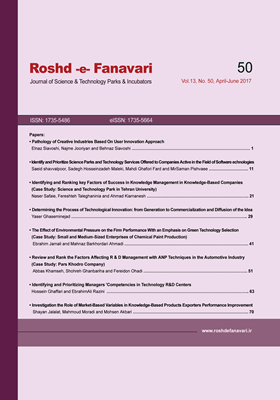-
-
List of Articles
-
Open Access Article
1 - Identify and Prioritize Science Parks and Technology Services Offered to Companies Active in the Field of Software Technologies
Saeed Shavalpour Sadegh HosseinZadeh Maleki Mehdi Ghafori Fard Mir Saman Pishvaee -
Open Access Article
2 - Identify and ranking of efficient strategic success factors of small early return firms in Kaveh industrial town with B.S.C. approach by managers point of view
hosein ghaffari ebrahimali razini -
Open Access Article
3 - Pathology of Creative Industries Based On User Innovation Approach
elnaz siavashi najme jooriyan behnaz siavashi -
Open Access Article
4 - Analysis of the factors affecting R & D management and rank the factors with ANP techniques in the automotive industry (Case Study: Pars Khodro Company)
Abass Khamse shohreh ghanbariha fereydon ohadi -
Open Access Article
5 - Identifying and Ranking Key Factors of Success in Knowledge Management in Knowledge-Based Companies (Case Study: Science and Technology Park in Tehran University)
naser safaei fereshte thaleghani Ahmad Kiamanesh -
Open Access Article
6 - Determining the Process of Technological Innovation: from Generation to Commercialization and Diffusion of the Idea
Yaser Ghasemi nejad -
Open Access Article
7 - Investigation the Role of Market-Based Variables in Knowledge-Based Products Exporters Performance Improvement
Shayan Jalalat Mahmoud Moradi Mohsen Akbari -
Open Access Article
8 - Identifying Risks of Oil Industry Projects Based on PMBOK’s Standard, and Ranking Them by Using FAHP & Fuzzy TOPSIS Case study: Tehran Jonoob Technical and Construction Company, in the Site of Persian Gulf Star Oil Company
ebrahim jamali mahnaz barkhordai ahmadi
-
The rights to this website are owned by the Raimag Press Management System.
Copyright © 2017-2025







